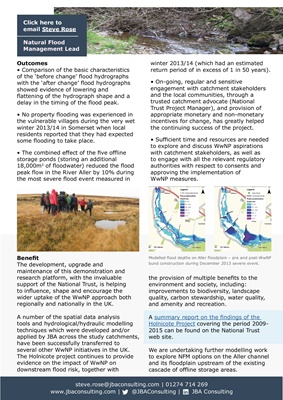
Outcomes
• Comparison of the basic characteristics
of the 'before change' flood hydrographs
with the 'after change' flood hydrographs
showed evidence of lowering and
flattening of the hydrograph shape and a
delay in the timing of the flood peak.
• No property flooding was experienced in
the vulnerable villages during the very wet
winter 2013/14 in Somerset when local
residents reported that they had expected
some flooding to take place.
• The combined effect of the five offline
storage ponds (storing an additional
18,000m3 of floodwater) reduced the flood
peak flow in the River Aller by 10% during
the most severe flood event measured in
winter 2013/14 (which had an estimated
return period of in excess of 1 in 50 years).
• On-going, regular and sensitive
engagement with catchment stakeholders
and the local communities, through a
trusted catchment advocate (National
Trust Project Manager), and provision of
appropriate monetary and non-monetary
incentives for change, has greatly helped
the continuing success of the project.
• Sufficient time and resources are needed
to explore and discuss WwNP aspirations
with catchment stakeholders, as well as
to engage with all the relevant regulatory
authorities with respect to consents and
approving the implementation of
WwNP measures.
the provision of multiple benefits to the
environment and society, including:
improvements to biodiversity, landscape
quality, carbon stewardship, water quality,
and amenity and recreation.
A summary report on the findings of the
Holnicote Project covering the period 2009-
2015 can be found on the National Trust
web site.
We are undertaking further modelling work
to explore NFM options on the Aller channel
and its floodplain upstream of the existing
cascade of offline storage areas.
Click here to
email Steve Rose
Natural Flood
Management Lead
Benefit
The development, upgrade and
maintenance of this demonstration and
research platform, with the invaluable
support of the National Trust, is helping
to influence, shape and encourage the
wider uptake of the WwNP approach both
regionally and nationally in the UK.
A number of the spatial data analysis
tools and hydrological/hydraulic modelling
techniques which were developed and/or
applied by JBA across the study catchments,
have been successfully transferred to
several other WwNP initiatives in the UK.
The Holnicote project continues to provide
evidence on the impact of WwNP on
downstream flood risk, together with
Modelled flood depths on Aller floodplain - pre and post-WwNP
bund construction during December 2013 severe event.
steve.rose@jbaconsulting.com | 01274 714 269
www.jbaconsulting.com | @JBAConsulting | JBA Consulting